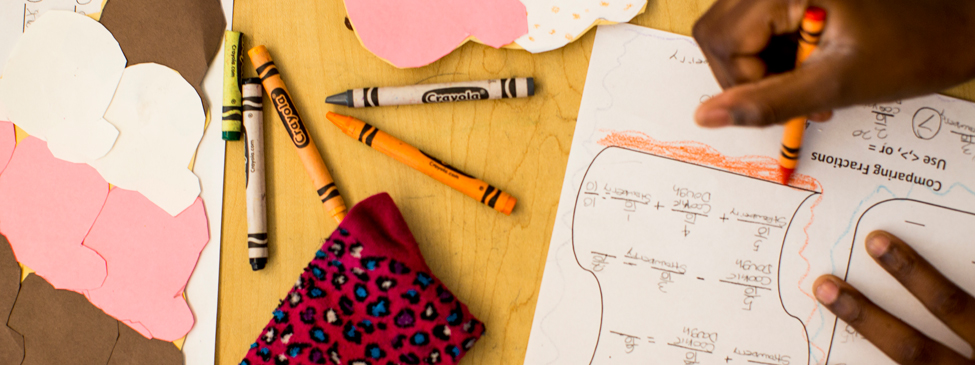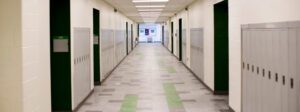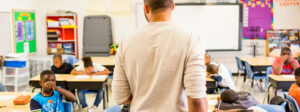Last year, we spoke with Rob Ovalle, principal of Campbell Park Elementary School in Pinellas County, Florida, about his school’s new approach to improving student behavior. At that point, Campbell Park had strategies in place to decrease infractions from 1,400 a year to less than 500. They met their goal and exceeded it. This year, the number of infractions is far lower. At a time when schools across the country are rethinking discipline strategies, we decided to follow up with Rob and Campbell Park’s behavior coach, Dean Lawless, to learn more about how they did it—and their priorities for the future.
Last time we talked, the number of discipline referrals in your school was around 450. Now you’re in the low 200s. How did that happen?
Dean: One of the big things we’ve done is eliminate the gray area around discipline and behavior. Students understand what is right and what is wrong, and what the consequences are. They know that if they skip class, they get an after school detention. They don't want after school detention, so they choose not to skip class. Also, because there are fewer infractions, there are more kids in class and more of our teachers’ time is spent on learning and teaching, as opposed to working with behavior.
Rob: This is important. We have shifted our focus from behavior to academics. Teachers are becoming more engaging in the classroom. There's more of an appeal for kids to stay in the classroom because instruction is challenging and stimulating. Students are not going to misbehave to get out of something they enjoy.
What benefits are you seeing as a result?
Dean: We have more time to put preventative things in place for some of our more struggling students. We're definitely not where we want to be all the time, but for some kids, we're making huge gains because we have time to come up with better tactics to help them out that don’t include suspending or expelling them.
Rob: I've seen a change in behaviors, especially in some of our “frequent flyers.” I’m thinking about one student, who I’ll call Samantha. Samantha will come in and say, “This happened at home. This happened on the street. Can you do something about it, Mr. Ovalle?” And that’s great. Because before, she would fly off the handle and take actions into her own hands.
We're able to do this now because we're not being reactive. We didn’t have time to have these one‑on‑one conversations before because we were trying to put our fingers in all the holes of this ship. But now we can create plans and specific interventions for students, not just something generic.
What’s an example of a new approach you’re able to take with a student who is particularly struggling?
Dean: I’m thinking of Jason (also not his real name). He was a student who was out of class more than he was in class. We were able to take a step back and work with his mom and one of our off‑site counselors. Together, we put a really concrete plan in place to encourage him to shift his behavior.
A big part of this plan was collaboration between home and school. When he was sent home for disruptive behavior, his mom followed through with more consequences, too. We’d follow up and support Mom. I'd call and check in. It’s wraparound support that gets everyone in his life involved. This worked. He went from never being in class to never being out of class.
How are you making sure students are engaged in class? What changes have you made to curriculum or academic strategy?
Rob: We’ve given teachers more of a voice. We're asking teachers to not just accept what's being given to them, but really take a look at it with the needs of their class in mind. We’ve also focused on the implementation of lessons. Sometimes, teachers write plans and then implement without thinking through the lesson or some of the misconceptions kids might have. We decided every week we’d ask a teacher in each subject to go through a lesson and teach like we are their students. In the room are peers, all four subject specific academic coaches, and the administrators.
We sit and we watch. We give them feedback. Sometimes, a coach will pause and say, “Did we think of this? Maybe we should change that.” At the end of those 45 minutes, everyone in the room has discussed, analyzed, and dissected a lesson that will be taught down the road. And we've made it a better lesson than it was before. There isn't time to do something that's not good in front of students. The practice gives teachers another level of confidence and understanding. It also shows other teachers in the room, “This is what good instruction looks like.”
It’s helpful for administrators, too. Because as we observe classrooms, we've seen the lesson and what it should look like. We can say “this was a great result” or “this didn't work so well, let’s keep tinkering.”
How are these new approaches affecting students? What progress do you hope to make in the next few years?
Dean: Right now and for the past few years, I think students have been focused on their behavior score. “What did I get? A one, two, three, four, or five?” I think we're starting to see a shift now, even in parents talking to kids. They aren’t asking for daily behavior scores. They’re asking, “What did you learn today? What are you working on?”
I think as we keep shifting from focusing on behavior to academics, even students who are doing great behaviorally will want to do better academically, as well. I think it will support a complete shift to a culture of scholarship and a culture of academics, as opposed to a culture of good behavior.
Rob: Things are starting to blossom. You can see it in the way students talk, with the way they talk about instruction. I happened to be in science lab recently and saw students discussing, arguing, and debating. They were examining the food chain and the food web with regards to owl pellets. It might not seem special, but these are conversations that wouldn’t happen three years ago. I think we've raised the level of expectations for students, and our students realize that. They are noticing we expect a lot more from them.
As we move forward, we want students to be better thinkers. We want students to be able to analyze their work and be smart consumers of what teachers give them. While, yes, it is important that letter grades are improving, it's not what drives us. We're not changing the way we work to fit the needs of an assessment. We're changing the way we work to meet the needs of our learners. If we do that well, everything else will take care of itself.





